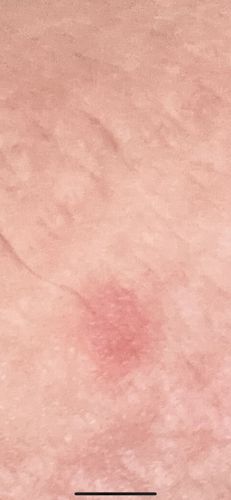Tick bite (Lyme disease rash)
Scientific Name: Not applicable to the image itself, as it shows a bite reaction, not the tick. However, the bull's-eye rash is clinically associated with Borrelia burgdorferi infection transmitted by ticks, primarily Ixodes scapularis or Ixodes pacificus.
Order & Family: Acari (mites and ticks), Ixodidae (hard ticks) or Argasidae (soft ticks). Specifically, the bull's-eye rash is characteristic of an Ixodes tick bite, often Ixodes scapularis (deer tick) in areas endemic for Lyme disease.
Size: Not applicable to the image, which shows a rash. However, adult ticks typically range from 2mm to 6mm, unengorged, and can swell considerably (up to 10-15mm) when engorged with blood.

Natural Habitat
While the image shows the effect on human skin rather than the bug itself, the characteristic rash (erythema migrans) suggests a tick bite. Ticks are commonly found in wooded, bushy, and grassy areas, including forests, prairies, and suburban gardens. They thrive in environments with ample vegetation and host animals.
Diet & Feeding
Ticks are obligate hematophages, meaning they feed exclusively on the blood of vertebrates (mammals, birds, reptiles, amphibians).
Behavior Patterns
Tick bites are often painless, allowing ticks to feed for hours or days without being noticed. They typically cling to vegetation and wait for a host to pass by (questing behavior). Once on a host, they crawl to a suitable feeding site, often in warm, moist areas of the body. After feeding, they detach and fall off.
Risks & Benefits
Risk: Ticks are vectors for various pathogens, including bacteria, viruses, and protozoa, which can cause diseases such as Lyme disease (indicated by the erythema migrans rash), Rocky Mountain spotted fever, anaplasmosis, babesiosis, and ehrlichiosis. Benefits: Ticks are a food source for some animals, but their primary ecological role is often debated given their disease transmission capabilities.
Identified on: 9/4/2025